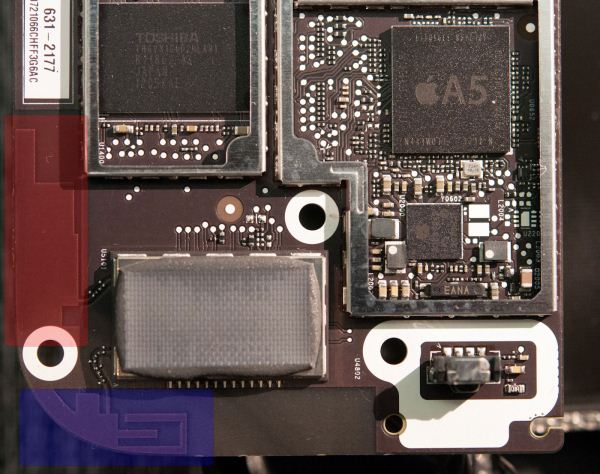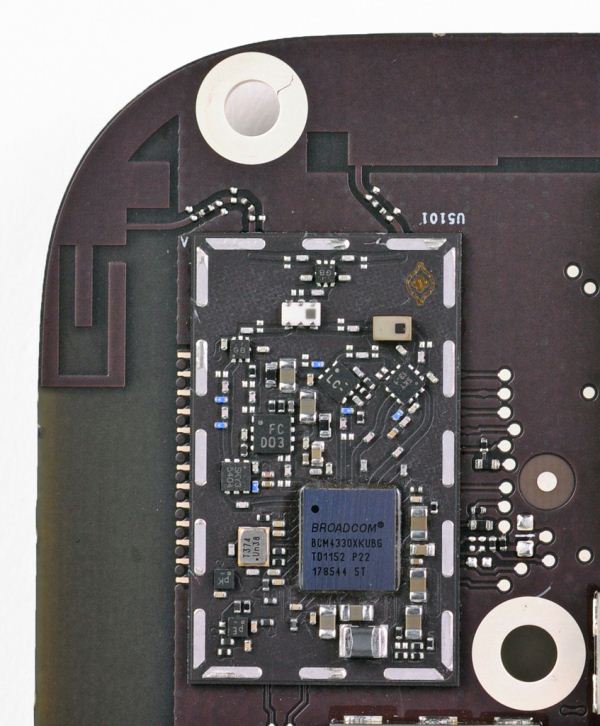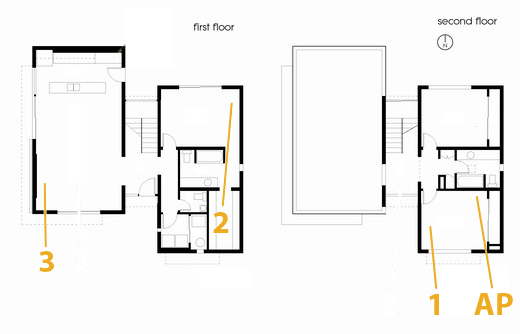Apple TV 3 (2012) Short Review - 1080p and better WiFi
by Brian Klug on March 21, 2012 4:21 PM ESTI touched on the fact that the Apple TV 3 now has two WiFi antennas printed on its PCB. The first appears to be of similar design to the Apple TV 2, and it's obvious from visual inspection that this is the case. The second is adjacent and shares the same ground plane / metal layer.

Antenna 1 (Encircled in blue), Antenna 2 (Encircled in red)
In addition, the Apple TV 3 also moves from Broadcom's BCM4329 802.11a/b/g/n and BT 2.0+EDR combo chip to BCM4330 802.11a/b/g/n and BT 4.0 combo chip which we've seen in the iPad 3, iPhone 4S, and countless other mobile devices. Seeing two RF chains, you might be led to think that the Apple TV 3 has 2x2:2, however this is not the case as the device still will only connect at 65 Mbps - single spatial stream, 20 MHz wide channels with the long guard interval. The maximum PHY rate and presence of 2.4 and 5 GHz band support is unchanged from Apple TV 2.

BCM4330 - Courtesy iFixit
One of the main complaints that I read online of the Apple TV 2 was its performance on 2.4 GHz. If you're living in the Apple ecosystem with an Airport Extreme or have a 5 GHz AP, this previously is something you could've not noticed entirely. In addition, multimedia streaming seems to be the ideal use case for 5 GHz WLAN thanks to both the ability to run 40 MHz channels and deal with less congestion. However, for users with 2.4 GHz networks, gain on that band is important.
It's obvious that the inclusion of a second WLAN chain and antenna is an attempt to improve RF performance further, even though the jump from 720p to 1080p for iTunes content doesn't increase bitrate very much at all (more later). To show just how much things have changed, I turned to the FCC documents for both Apple TV models which spell out antenna gain. Interestingly enough, the FCC also had internal photos up and posted the day the Apple TV 3 went on sale, which could've saved everyone some teardown time.
| Apple TV 2 and 3 - Antenna Gain | ||||||||
| Antenna | Apple TV 3 (A5) (BCGA1427) | Apple TV 2 (A4) (BCGA1378) | ||||||
| Band (MHz) | Ant 1 (dBi) | Ant 2 (dBi) | Ant 1 (dBi) | |||||
| 2400-2483.5 | 3.7 | - | 0.49 | |||||
| 5150-5120 | 4.5 | 2.4 | 2.76 | |||||
| 5250-5350 | 4.1 | - | 2.95 | |||||
| 5470-5725 | 4.5 | - | 4.09 | |||||
| 5745-5850 | 4.6 | - | 1.42 | |||||
The table above contains the antenna gains for both models, and you can immediately see just how little gain there was previously for the Apple TV 2 on 2.4 GHz. Gain is now majorly improved on the 2.4 GHz band, and also improved on other parts of the 5 GHz band. You'll notice that antenna 2 on the Apple TV 3 only gets used (at least for transmit) on the 5.2 GHz band - channels 36 to 48. This is the small band below the DFS-enabled 5 GHz band (52-140). Remember that the "best" 5 GHz channels in the USA are the traditional 802.11a channels 149-165 since you can run with higher power. BCM4330 supports optional external antenna diversity - it's entirely possible this is also being used on the receive side.
So what does this translate to in terms of actual RF performance now? To find out, I tested the Apple TV at three places in my house where I ran the previous model. Downstairs in my home theater shelf, a location which is awful for WiFi (I've run powerline here), downstairs in the bedroom (ironically on a 720p TV), and upstairs in my office on another TV right next to the AP for a baseline.

Location 1 corresponds to the office environment right next to the AP, location 2 is the bedroom TV, and location 3 is the main TV cabinet. I setup the Apple TV 2 and 3 in all three locations like I normally would and fired up the Netflix example short test videos to ensure constant network traffic. I then watched the received signal strength and noise metrics reported from an Airport Extreme 5th gen.
| Apple TV 2 and 3 - Antenna Gain | |||||||||||||
| Antenna | Apple TV 3 (A5) (BCGA1427) | Apple TV 2 (A4) (BCGA1378) | |||||||||||
| Location | Signal (dBm) | Noise (dB) | Rate (Mbps) | Band (GHz) | Signal (dBm) | Noise (dB) | Rate (Mbps) | Band (GHz) | |||||
| 1 - Office | -47 | -87 | 65 | 5 | -50 | -90 | 65 | 5 | |||||
| 2 - Bedroom | -71 | -90 | 65 | 2.4 | -78 | -90 | 58 | 5 | |||||
| 3 - Living Room | -69 | -85 | 65 | 2.4 | -80 | -90 | 52 | 5 | |||||
I have my network setup with one SSID for both 2.4 and 5 GHz networks, and let devices choose which band. The Apple TV 3 seems to have a higher affinity for 2.4 GHz in the more difficult downstairs propagation environments, no doubt which comes from it being able to negotiate a higher PHY rate on 2.4 GHz as opposed to 5 GHz. In all three places, it latches onto the single spatial stream 20 MHz channel long guard interval 65 Mbps rate, where the Apple TV 2 previously selected lower MCS categories on 5 GHz.
The takeaway is that the new Apple TV 3 gets better WiFi reception on both bands and thus can be placed further from the AP. This is something which no doubt will be much appreciated by users who have challenging home theater locations. Part of the reason is also no doubt to accommodate 1080p versus 720p content, though for iTunes content bitrate only changes from ~4 Mbps to ~5 Mbps. The other big new bandwidth consumer is of course iTunes Match. Obviously it goes without saying that Apple's media streamer device needs to have good connectivity to do its job, and the WiFi improvement makes a dramatic difference if you don't already have ethernet wherever you've located your TV.










37 Comments
View All Comments
Fanfoot - Tuesday, March 27, 2012 - link
One of the things I wish Apple would do with this device is to enable support of HDMI CEC. From the few posts I've seen on the subject it looks like Apple has once again failed to incorporate this into the new Apple TV 3.Why does this matter? Because with HDMI CEC if I want to AirPlay something from my iPhone I would just click through to use AirPlay on my iPhone and bang my TV would automatically switch to the Apple TV input without my having to do anything. As it is I have to a) hit the input button on my TiVo remote a bunch of times, then b) because my Samsung monitor is stupid and won't time out and get rid of the input list EVER I have to find my Samsung TV remote and press "OK" THEN initiate AirPlay from my iPhone. Which is STUPID.
Lots and lots of TVs and receivers and so forth support HDMI CEC now. I don't understand why Apple doesn't support it, even as a user-enabled option...
Eug - Wednesday, March 28, 2012 - link
Maybe I'm misreading the article, but it sounds like it's suggesting the Apple TV 2 is still limited to 720p playback. This is not actually the case. The new Apple TV 2 OS update that landed when Apple TV 3 was released has allowed playback of 1080p on the Apple TV 2 as well, including iTunes 1080p.Sure, the output is still limited to 720p but the key here is that the OS update has allowed much better 1080p support for the Apple TV 2.
Previously most 1080p I encoded myself would stutter on Apple TV 2. So, I just encoded them at 720p. However, since the OS update, I've tried a couple of non-iTunes 1080p files, and they work perfectly fine now, without stuttering. Going forward, all my encodes for Apple TV 2 will be 1080p.
It would be nice to see in a future article limitations of 1080p support with Apple TV 2 as compared to Apple TV 3, in terms of things like stuttering, etc. vs. bitrates. However, I wouldn't be surprised to see Apple TV 2 fully capable of smooth 25 Mbps high profile level 4.0 content just like its younger brother, Apple TV 3.
MadMacMan - Saturday, March 31, 2012 - link
Great review, as always! :) Am I too late to the party or are there any Roku 2 (XS or XD) users who can chime in about the performance of WDTV vs. the aforementioned 1080p-capable Roku 2 players vs. the Apple TV 2 or 3? What are the main differences?Anand, since you mentioned it, I've been running OS X 10.8 Mountain Lion and the additional AirPlay mirroring features that you alluded to are indeed extremely useful! Consider this: Running 1080p content in VLC on my MBP and then clicking on AirPlay will mirror the entire desktop quickly and quite beautifully, VLC playing 1080p or 720p or whatever very much included! So far, there are only HiDPI profiles for 1280x720, though, which will hopefully change to include 1920x1080 by the time OS X 10.8 is released to the public.
Dug - Monday, April 2, 2012 - link
I have an iPad2 and Apple TV 2.I think the combo is is one of the best as far as entertainment and music playing goes.
Playing rdio, pandora, movies, music, garage band, icloud, etc is a whole different experience when you have an iPad as a controller because you have essentially a different interface to quickly select things.
I would like to see an update with the new iPad and Apple TV 3 when you get a chance.
I'm curious how developers with higher resolution apps work with the Apple TV now. I would also like to see how it handles mirroring.
kaki4125 - Thursday, August 16, 2012 - link
If you are HD 1080P videos crazy fans and are looking for the ways to playing 1080P videos on your Apple TV you can use iFunia Apple TV Video Converter to convert all your HD Videos for Apple TVmakuvad - Tuesday, February 6, 2018 - link
Or then again you might, you be able to know, purchase an old macintosh smaller than normal second hand, equip it with an EyeTV stick or two, and have a truly kick-ass HTPC. There's more than one decision for the TV set in the Apple universe. Nobody's constraining you to purchase an AppleTV if it's wrong for you - that would be as stupid as purchasing an iPod Touch at that point whining that it sucks as a telephone since all it offers is Skype and Vibr, not genuine telephone usefulness. http://www.makuv.in/BWMerlin - Saturday, September 7, 2019 - link
I know this comment is many years after this article was posted but I found the detailed information about the antenna set up, spatial stream, channel width etc extremely useful.